New Mexico
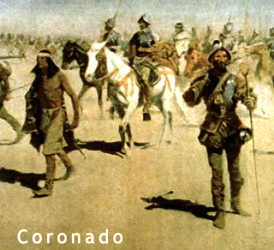
The Old West In New Mexico | New Mexico PBS
http://www.newmexicopbs.org – A colorful history lesson about frontier New Mexico’s unofficial town hall — the saloon. This documentary travels back in time to profile three of New Mexicos most famous watering holes and the historical events that took place around and within them. The events that unfold help us better understand the history of New Mexico. We learn of mining, apache wars and melodrama at the Buckhorn in Pinos Altos. We also learn about the Wild West gunfights that occurred at the infamous St. James Hotel in Cimarron and stories of the Mexican revolution featuring Benito Juarezs dramatic speech at the Double Eagle in Mesilla as he rallied Mexican exiles to join him in fighting for independence.
 Timeline of New Mexico: 1200’s – 1500’s
Timeline of New Mexico: 1200’s – 1500’s
- (1200’s – 1500’s) Pueblo Indians established villages along the Rio Grande and its tributaries
- (1536) Cabeza de Vaca, Estevan the Moor, and others began rumors of the Seven Cities of Cibola (Gold)
- (1540) Francisco Vasquez de Coronado, while searching for that gold, discovered the Grand Canyon
- (1598) Juan de Onate established San Juan de los Caballeros as the capital
1600’s
- (1600) San Gabriel founded as the second capital
- (1601) Colonists deserted San Gabriel
- (1609) Governor Pedro de Peralta established new capital at Santa Fe
- (1626) Spanish Inquisition established
- (1641) Governor Luis de Rosas assassinated
- (1680) Pueblo Indians forced colonists and Spaniards to retreat to Mexico
1700’s – 1800’s
- (1706) Villa de Albuquerque founded
- (1743) trappers reached Santa Fe
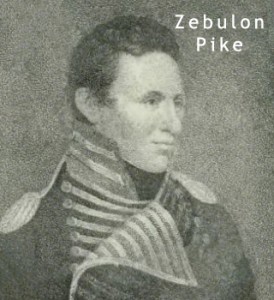 (1807) Zebulon Pike led first Anglo-American expedition to New Mexico
(1807) Zebulon Pike led first Anglo-American expedition to New Mexico- (1821) Mexico declared independence from Spain; Santa Fe Trail opened
- (1828) Gold discovered in Ortiz Mountains
- (1837) Governor Albino Perez and top officials assassinated in revolt against Mexican taxation
- (1846) Mexican-American War began; Stephen Watts Kearny annexed New Mexico to U.S.
- (1848) Mexican-American War ended; Treaty of Guadalupe Hidalgo signed
- (1850) New Mexico designated a territory; denied statehood
- (1854) Gadsden Purchase added 45,000 square miles to territory
- (1861) Confederates invaded New Mexico; Territory lost northern-most section; Territories of Arizona and Colorado created
- (1863-1864) The Long Walk – Navajos and Apaches relocated to Bosque Redondo
- (1868) Navajos and Apaches return to homelands
- (1878) Railroad arrived
- (1881) Billy the Kid shot
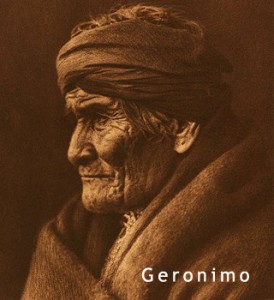 (1886) Geronimo surrenders; Indian uprisings ceased
(1886) Geronimo surrenders; Indian uprisings ceased- (1898) Thomas Alva Edison produced first motion picture in New Mexico
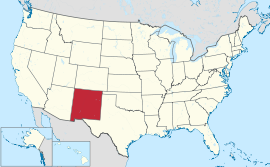 New Mexico (
New Mexico (![]() i/nuː ˈmɛksɨkoʊ/) is a state located in the southwest and western regions of the United States. New Mexico is also usually considered one of theMountain States. New Mexico is the 5th most extensive, the 36th most populous, and the 6th least densely populated of the 50 United States.
i/nuː ˈmɛksɨkoʊ/) is a state located in the southwest and western regions of the United States. New Mexico is also usually considered one of theMountain States. New Mexico is the 5th most extensive, the 36th most populous, and the 6th least densely populated of the 50 United States.
Inhabited by Native American populations for many centuries, New Mexico has also been part of the Imperial Spanish viceroyalty of New Spain, part of Mexico, and aU.S. territory. Among U.S. states, New Mexico has the highest percentage ofHispanics, including descendants of Spanish colonists and recent immigrants from Latin America. It also has the second-highest percentage of Native Americans, afterAlaska, and the fourth-highest total number of Native Americans after California, Oklahoma, and Arizona. The tribes in the state consist of mostly Navajo and Pueblo peoples. As a result, the demographics and culture of the state are unique for their strong Hispanic and Native American influences. The flag of New Mexico is represented by the red and gold colors, which represent Spain, as well as the Ziasymbol, an ancient Native American symbol for the sun.
History
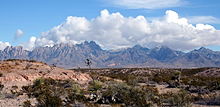 The first known inhabitants of New Mexico were members of the Clovis culture of Paleo-Indians. Later inhabitants include American Indians of the Mogollon and Anasazicultures. By the time of European contact in the 16th century, the region was settled by the villages of the Pueblo peoples and groups of Navajo, Apache and Ute.
The first known inhabitants of New Mexico were members of the Clovis culture of Paleo-Indians. Later inhabitants include American Indians of the Mogollon and Anasazicultures. By the time of European contact in the 16th century, the region was settled by the villages of the Pueblo peoples and groups of Navajo, Apache and Ute.
Francisco Vázquez de Coronado assembled an enormous expedition at Compostela in 1540–1542 to explore and find the mystical Seven Golden Cities of Cibola as described by Fray Marcos de Niza. The name Nuevo México was first used by a seeker of gold mines named Francisco de Ibarra who explored far to the north of Mexico in 1563 and reported his findings as being in “a New Mexico.” Juan de Oñate officially established the name when he was appointed the first governor of the new Province of New Mexico in 1598. The same year he founded the San Juan de los Caballeros colony, the first permanent European settlement in the future state of New Mexico, on the Rio Grande near Ohkay Owingeh Pueblo. Oñate extended El Camino Real de Tierra Adentro, “Royal Road of the Interior,” by 700 miles (1,100 km) from Santa Bárbara, Chihuahua to his remote colony.
The settlement of Santa Fe was established at the foot of the Sangre de Cristo Mountains, the southernmost subrange of the Rocky Mountains, around 1608. The city, along with most of the settled areas of the state, was abandoned by the Spanish for 12 years (1680–1692) as a result of the successful Pueblo Revolt. After the death of the Pueblo leader Popé, Diego de Vargas restored the area to Spanish rule. While developing Santa Fe as a trade center, the returning settlers founded Albuquerque in 1706 from existing surrounding communities, naming it for the viceroy of New Spain, Francisco Fernández de la Cueva, 10th Duke of Alburquerque.
As a part of New Spain, the claims for the province of New Mexico passed to independent Mexico in 1821 following the Mexican War of Independence. The Republic of Texas claimed the portion east of the Rio Grande when it seceded from Mexico in 1836. Texas was separated from New Mexico by the Comancheria and its only attempt to establish a presence or control in the claimed territory was the failed Texas Santa Fe Expedition. The extreme northeastern part of New Mexico was originally ruled by France, and sold to the United States as part of the Louisiana Purchase in 1803. By 1800 the Spanish population had reached 25,000, but Apache and Comanche raids on Hispanic settlers were common until well into the period of U.S. occupation.
Following the Mexican-American War, from 1846–1848 and the Treaty of Guadalupe Hidalgo in 1848, Mexico ceded its mostly unsettled northern holdings, today known as the American Southwest and California, to the United States of America. In the Compromise of 1850 Texas ceded its claims to the area lying east of the Rio Grande in exchange for ten million dollars and the US government established the New Mexico Territory on September 9, 1850, including most of the present-day states of Arizona and New Mexico, and part of Colorado. The United States acquired the southwestern boot heel of the state and southernArizona below the Gila river in the mostly desert Gadsden Purchase of 1853, which was related to the construction by the US of a transcontinental railroad.
New Mexico played a role in the Trans-Mississippi Theater of the American Civil War. Both Confederate and Union governments claimed ownership and territorial rights over New Mexico Territory. In 1861 the Confederacy claimed the southern tract as its own Arizona Territory and waged the ambitious New Mexico Campaign in an attempt to control the American Southwest and open up access to Union California. Confederate power in the New Mexico Territory was effectively broken after the Battle of Glorieta Pass in 1862. However, the Confederate territorial government continued to operate out of Texas, and Confederate troops marched under the Arizona flag until the end of the war. Additionally, over 8,000 troops from New Mexico Territory served the Union.
Congress admitted New Mexico as the 47th state in the Union on January 6, 1912.
During World War II, the first atomic bombs were designed and manufactured at Los Alamos and the first was tested at Trinity site in the desert on the White Sands Proving Grounds between Socorro and Alamogordo.
The first known inhabitants of New Mexico were members of the Clovis culture of Paleo-Indians. Later inhabitants include American Indians of the Mogollon and Anasazicultures. By the time of European contact in the 16th century, the region was settled by the villages of the Pueblo peoples and groups of Navajo, Apache and Ute.
Francisco Vázquez de Coronado assembled an enormous expedition at Compostela in 1540–1542 to explore and find the mystical Seven Golden Cities of Cibola as described by Fray Marcos de Niza. The name Nuevo México was first used by a seeker of gold mines named Francisco de Ibarra who explored far to the north of Mexico in 1563 and reported his findings as being in “a New Mexico.” Juan de Oñate officially established the name when he was appointed the first governor of the new Province of New Mexico in 1598. The same year he founded the San Juan de los Caballeros colony, the first permanent European settlement in the future state of New Mexico, on the Rio Grande near Ohkay Owingeh Pueblo. Oñate extended El Camino Real de Tierra Adentro, “Royal Road of the Interior,” by 700 miles (1,100 km) from Santa Bárbara, Chihuahua to his remote colony.
The settlement of Santa Fe was established at the foot of the Sangre de Cristo Mountains, the southernmost subrange of the Rocky Mountains, around 1608. The city, along with most of the settled areas of the state, was abandoned by the Spanish for 12 years (1680–1692) as a result of the successful Pueblo Revolt. After the death of the Pueblo leader Popé, Diego de Vargas restored the area to Spanish rule. While developing Santa Fe as a trade center, the returning settlers founded Albuquerque in 1706 from existing surrounding communities, naming it for the viceroy of New Spain, Francisco Fernández de la Cueva, 10th Duke of Alburquerque.
As a part of New Spain, the claims for the province of New Mexico passed to independent Mexico in 1821 following the Mexican War of Independence. The Republic of Texas claimed the portion east of the Rio Grande when it seceded from Mexico in 1836. Texas was separated from New Mexico by the Comancheria and its only attempt to establish a presence or control in the claimed territory was the failed Texas Santa Fe Expedition. The extreme northeastern part of New Mexico was originally ruled by France, and sold to the United States as part of the Louisiana Purchase in 1803. By 1800 the Spanish population had reached 25,000, but Apache and Comanche raids on Hispanic settlers were common until well into the period of U.S. occupation.
Following the Mexican-American War, from 1846–1848 and the Treaty of Guadalupe Hidalgo in 1848, Mexico ceded its mostly unsettled northern holdings, today known as the American Southwest and California, to the United States of America. In the Compromise of 1850 Texas ceded its claims to the area lying east of the Rio Grande in exchange for ten million dollars and the US government established the New Mexico Territory on September 9, 1850, including most of the present-day states of Arizona and New Mexico, and part of Colorado. The United States acquired the southwestern boot heel of the state and southern Arizona below the Gila river in the mostly desert Gadsden Purchase of 1853, which was related to the construction by the US of atranscontinental railroad.
New Mexico played a role in the Trans-Mississippi Theater of the American Civil War. Both Confederate and Union governments claimed ownership and territorial rights over New Mexico Territory. In 1861 the Confederacy claimed the southern tract as its own Arizona Territory and waged the ambitious New Mexico Campaign in an attempt to control the American Southwest and open up access to Union California. Confederate power in the New Mexico Territory was effectively broken after the Battle of Glorieta Pass in 1862. However, the Confederate territorial government continued to operate out of Texas, and Confederate troops marched under the Arizona flag until the end of the war. Additionally, over 8,000 troops from New Mexico Territory served the Union.
Congress admitted New Mexico as the 47th state in the Union on January 6, 1912.
During World War II, the first atomic bombs were designed and manufactured at Los Alamos and the first was tested at Trinity site in the desert on the White Sands Proving Grounds between Socorro and Alamogordo.
New Mexico has benefited from federal government spending. It is home to three Air Force bases, White Sands Missile Range, and the federal research laboratories Los Alamos National Laboratoryand Sandia National Laboratories. The state’s population grew rapidly after World War II, going from 531,818 in 1940 to 1,819,046 in 2000. Employment growth areas in New Mexico include microelectronics, call centers, and Indian casinos.

